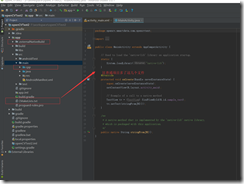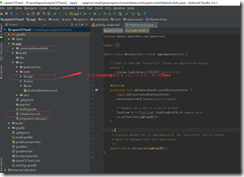您好,登錄后才能下訂單哦!
您好,登錄后才能下訂單哦!
Note:這篇文章是基于Android Studio 3.01版本的,NDK是R16。
step1:創建一個包含C++的項目


其他默認就可以了。
C++ Standard
指定編譯庫的環境,其中Toolchain Default使用的是默認的CMake環境;C++ 11也就是C++環境。兩種環境都可以編庫,至于區別,后續會跟進,當前博文使用的是CMake環境。
Exceptions Support
如果選中復選框,則表示當前項目支持C++異常處理,如果支持,在項目Module級別的build.gradle文件中會增加一個標識 -fexceptions到cppFlags屬性中,并且在so庫構建時,gradle會把該屬性值傳遞給CMake進行構建。
Runtime Type Information Support
同理,選中復選框,項目支持RTTI,屬性cppFlags增加標識-frtti
切換到project 模式,生成的目錄的結構如下:


3、認識CMakeLists.txt構建腳本文件
CMakeLists.txt文件用于配置JNI項目屬性,主要用于聲明CMake使用版本、so庫名稱、C/CPP文件路徑等信息,下面是該文件內容:
# For more information about using CMake with Android Studio, read the
# documentation: https://d.android.com/studio/projects/add-native-code.html
# Sets the minimum version of CMake required to build the native library.
cmake_minimum_required(VERSION 3.4.1)
# Creates and names a library, sets it as either STATIC
# or SHARED, and provides the relative paths to its source code.
# You can define multiple libraries, and CMake builds them for you.
# Gradle automatically packages shared libraries with your APK.
add_library( # Sets the name of the library.
native-lib
# Sets the library as a shared library.
SHARED
# Provides a relative path to your source file(s).
src/main/cpp/native-lib.cpp )
# Searches for a specified prebuilt library and stores the path as a
# variable. Because CMake includes system libraries in the search path by
# default, you only need to specify the name of the public NDK library
# you want to add. CMake verifies that the library exists before
# completing its build.
find_library( # Sets the name of the path variable.
log-lib
# Specifies the name of the NDK library that
# you want CMake to locate.
log )
# Specifies libraries CMake should link to your target library. You
# can link multiple libraries, such as libraries you define in this
# build script, prebuilt third-party libraries, or system libraries.
target_link_libraries( # Specifies the target library.
native-lib
# Links the target library to the log library
# included in the NDK.
${log-lib} )
cmake_minimum_required(VERSION 3.4.1)
CMake最小版本使用的是3.4.1。
add_library()
配置so庫信息(為當前當前腳本文件添加庫)
native-lib
這個是聲明引用so庫的名稱,在項目中,如果需要使用這個so文件,引用的名稱就是這個。值得注意的是,實際上生成的so文件名稱是libnative-lib。當Run項目或者build項目是,在Module級別的build文件下的intermediates\transforms\mergeJniLibs\debug\folders\2000\1f\main下會生成相應的so庫文件。
SHARED
這個參數表示共享so庫文件,也就是在Run項目或者build項目時會在目錄intermediates\transforms\mergeJniLibs\debug\folders\2000\1f\main下生成so庫文。此外,so庫文件都會在打包到.apk里面,可以通過選擇菜單欄的Build->Analyze Apk...*查看apk中是否存在so庫文件,一般它會存放在lib目錄下。
src/main/cpp/native-lib.cpp
構建so庫的源文件。
STATIC:靜態庫,是目標文件的歸檔文件,在鏈接其它目標的時候使用。
SHARED:動態庫,會被動態鏈接,在運行時被加載。
MODULE:模塊庫,是不會被鏈接到其它目標中的插件,但是可能會在運行時使用dlopen-系列的函數動態鏈接。
頭文件
也可以配置頭文件路徑,方法是(注意這里指定的是目錄而非文件):
include_directories([AFTER|BEFORE] [SYSTEM] dir1 [dir2 ...])
下面的配置實際上與自定義的JNI項目(自定義的so庫)沒有太大關系。
find_library()
這個方法與我們要創建的so庫無關而是使用NDK的Apis或者庫,默認情況下Android平臺集成了很多NDK庫文件,所以這些文件是沒有必要打包到apk里面去的。直接聲明想要使用的庫名稱即可(猜測:貌似是在Sytem/libs目錄下)。在這里不需要指定庫的路徑,因為這個路徑已經是CMake路徑搜索的一部分。如示例中使用的是log相關的so庫。
log-lib
這個指定的是在NDK庫中每個類型的庫會存放一個特定的位置,而log庫存放在log-lib中
log
指定使用log庫
target_link_libraries()
如果你本地的庫(native-lib)想要調用log庫的方法,那么就需要配置這個屬性,意思是把NDK庫關聯到本地庫。
native-lib
要被關聯的庫名稱
${log-lib}
要關聯的庫名稱,要用大括號包裹,前面還要有$符號去引用。
實際上,我們可以自己創建CMakeLists.txt文件,而且路徑不受限制,只要在build.gradle中配置externalNativeBuild.cmake.path來指定該文件路徑即可。
add_subdirectory 可以執行子路徑的CMakeLists.txt
添加自定義的C++庫mathlib
創建源文件
我的項目名稱為OpenCVTest,所以右鍵這個項目點擊New->Module,然后選Android Library,輸入庫的名稱MathLib,然后Finish,系統就會生成對應的模塊,并構建好初始的目錄樹。系統將庫命名為MathLib,但是目錄樹中還是小寫的mathlib。這個時候系統會自動在頂級settings.gradle添加對于這個新模塊的include語句。并且在模塊目錄下構建好了初始的build.gradle。
現在我們開始創建自己的C++庫,首先右鍵mathlib目錄下的src/main,然后選擇New->Directory,輸入cpp并確定。這個目錄就是我們要創建的庫的源文件的位置。
右鍵add,點擊New->C/C++ Source File,輸入add.cpp,并選中Create an associated header。
在.cpp文件中定義好一個簡單的加法函數,并在.h文件中添加好對應聲明。
add.cpp
#include "add.h"
int add(int a,int b) {
return a + b;
}
add.h
#ifndef OPENCVTEST_ADD_H
#define OPENCVTEST_ADD_H
int add(int a,int b);
#endif //OPENCVTEST_ADD_H
將源文件關聯到構建系統中
我們用CMake來構建C++庫,然后CMake又要和gradle結合,在Android Studio里面協作管理C++和Java的代碼。
我們在模塊mathlib的根目錄下創建一個名為CMakeLists.txt的文件,寫入
cmake_minimum_required(VERSION 3.4.1)
add_library(add SHARED
src/main/cpp/add.cpp)
set(distribution_DIR ${CMAKE_CURRENT_SOURCE_DIR}/../distribution)
set_target_properties(add PROPERTIES
LIBRARY_OUTPUT_DIRECTORY
${distribution_DIR}/libs/${ANDROID_ABI})
target_include_directories(add
PUBLIC ${CMAKE_CURRENT_SOURCE_DIR}/src/main/cpp)
add_custom_command(TARGET add POST_BUILD
COMMAND "${CMAKE_COMMAND}" -E
copy "${CMAKE_CURRENT_SOURCE_DIR}/src/main/cpp/add.h"
"${distribution_DIR}/include/mathlib/add.h"
# **** the following 2 lines are for potential future debug purpose ****
# COMMAND "${CMAKE_COMMAND}" -E
# remove_directory "${CMAKE_CURRENT_BINARY_DIR}"
COMMENT "Copying gmath to output directory")
set可以自定義變量。這里定義生成so文件的目錄
set_target_properties 命令的意思是設置目標的一些屬性來改變它們構建的方式。這個命令中設置了 add的ARCHIVE_OUTPUT_DIRECTORY 屬性。也就是改變了輸出路徑。
add_custom_command 命令是自定義命令。命令中把頭文件也復制到了 distribution_DIR 中。
target_include_directories,它對創建的庫設置include路徑,針對目標來設置,可以避免與其他庫的沖突,并且此時對自定義的庫設置好了此路徑后,后續導入這個庫就不需要再次設置了。但對于預構建的庫,就需要設置,稍后會有詳細講解。
接下來我們在模塊mathlib的build.gradle中的defaultConfig{}中添加如下語句:
externalNativeBuild {
cmake {
arguments '-DANDROID_PLATFORM=android-19',
'-DANDROID_TOOLCHAIN=clang', '-DANDROID_STL=gnustl_static'
targets 'add'
}
}
這里arguments是編譯參數,而targets則是相比于add_subdirectory更高權限的方法。一般來說可以把它刪去,即默認構建所有目標。
然后在android{}最后添加如下語句,將CMakeLists.txt關聯起來。
externalNativeBuild {
cmake {
path 'CMakeLists.txt'
}
}
C++庫已經創建好了,接下來就要在主模塊中使用它了。
為了使用自定義C++庫,我們需要一個中間人,它從Android本身的Java程序中獲取請求,然后使用我們的C++庫中的函數計算得到結果,并將數據傳回Android本身的Java程序中。
創建一個中間文件native-math.cpp
#include <jni.h>
#include <string>
#include "mathlib/add.h"
extern "C"
JNIEXPORT jstring
JNICALL
Java_com_example_bill_opencvtest_MainActivity_stringFromJNI(
JNIEnv *env,
jobject /* this */) {
std::string hello = "Hello from C++ From Android openCVTest";
return env->NewStringUTF(hello.c_str());
}
extern "C"
JNIEXPORT jint JNICALL
Java_com_example_bill_opencvtest_MainActivity_addFromCpp(JNIEnv *env, jobject instance, jint a,
jint b) {
// TODO
return add(a,b);
}
在app/CMakeLists.txt 加上這個自定義庫的引用
set(distribution_DIR ${CMAKE_SOURCE_DIR}/../distribution)
include_directories(${distribution_DIR}/include)
add_library(lib_add SHARED IMPORTED)
set_target_properties(lib_add PROPERTIES IMPORTED_LOCATION
${distribution_DIR}/libs/${ANDROID_ABI}/libadd.so)
add_library( # Sets the name of the library.
native-math
# Sets the library as a shared library.
SHARED
# Provides a relative path to your source file(s).
src/main/cpp/native-math.cpp )
find_library( # Sets the name of the path variable.
log-lib
# Specifies the name of the NDK library that
# you want CMake to locate.
log )
set_target_properties(native-math PROPERTIES
LIBRARY_OUTPUT_DIRECTORY
${distribution_DIR}/libs/${ANDROID_ABI})
target_link_libraries( # Specifies the target library.
native-math
android
log
lib_add
# Links the target library to the log library
# included in the NDK.
${log-lib} )
在模塊app的局部build.gradle中,像之前一樣添加好對應的語句:
defaultConfig{}中:
externalNativeBuild {
cmake {
arguments '-DANDROID_PLATFORM=android-19',
'-DANDROID_TOOLCHAIN=clang', '-DANDROID_STL=gnustl_static'
}
}
ndk {
//abiFilters 'armeabi-v7a','x86_64'
}
其中ndk指定abi平臺
ABI(Application binary interface)應用程序二進制接口。不同的CPU 與指令集的每種組合都有定義的 ABI (應用程序二進制接口),一段程序只有遵循這個接口規范才能在該 CPU 上運行,所以同樣的程序代碼為了兼容多個不同的CPU,需要為不同的 ABI 構建不同的庫文件。當然對于CPU來說,不同的架構并不意味著一定互不兼容。
armeabi設備只兼容armeabi;
armeabi-v7a設備兼容armeabi-v7a、armeabi;
arm64-v8a設備兼容arm64-v8a、armeabi-v7a、armeabi;
X86設備兼容X86、armeabi;
X86_64設備兼容X86_64、X86、armeabi;
mips64設備兼容mips64、mips;
mips只兼容mips;
接著在src/main/java/*/MainActivity.java中的MainActivity類下面,加載庫,以及設置好對應的方法聲明:
static {
System.loadLibrary("native-math");
}
/**
* A native method that is implemented by the 'native-lib' native library,
* which is packaged with this application.
*/
public native String stringFromJNI();
public native int addFromCpp(int a, int b);
然后就可以在onCreate方法中使用這個C++庫定義的函數,在Java中對應的函數了
super.onCreate(savedInstanceState); setContentView(R.layout.activity_main); // Example of a call to a native method TextView tv = (TextView) findViewById(R.id.sample_text); tv.setText(stringFromJNI() + "____" + addFromCpp(2,88));
最后別忘了在項目中添加模塊的依賴關系才可以正常運行這個Android App。右鍵項目OpenCVTest,選擇Open Module Settings。選擇app->Dependencies,添加Module dependency,選擇mathlib,確定即可
添加OpenCV庫的支持
導入OpenCV進項目
從OpenCV的官網將OpenCV4Android 3.4下載下來,解壓到某個目錄。
點擊Android Studio的File->New->Import Module,然后選擇路徑為OpenCV-android-sdk/sdk/java,確定。并在導入之后,修改build.gradle中的SDK版本。
在Open Module Settings中添加模塊的依賴關系,使app依賴openCVLibrary340。
現在已經可以在.java文件中看得到OpenCV的自動補全了。
配置OpenCV的C++預構建庫
把包含文件夾OpenCV-android-sdk/sdk/native/jni/include和預構建庫文件夾OpenCV-android-sdk/sdk/native/libs也復制到項目的distribution中。
由于之前已經在添加C++庫時修改了app的build.gradle,所以這個步驟現在不需要再執行了。
由于OpenCV是預構建庫,所以沒有編譯的過程,因此模塊openCVLibrary320中不需要添加CMakeLists.txt等。我們直接在app模塊中根目錄下的CMakeLists.txt導入OpenCV的庫即可。
set(libs "${CMAKE_SOURCE_DIR}/src/main/jniLibs")
include_directories(${distribution_DIR}/include)
# set add lib
add_library(libopencv_java3 SHARED IMPORTED )
set_target_properties(libopencv_java3 PROPERTIES
IMPORTED_LOCATION "${libs}/${ANDROID_ABI}/libopencv_java3.so")
add_library( # Sets the name of the library.
native-opencv
# Sets the library as a shared library.
SHARED
# Provides a relative path to your source file(s).
src/main/cpp/native-opencv.cpp )
set_target_properties(native-opencv PROPERTIES
LIBRARY_OUTPUT_DIRECTORY
${distribution_DIR}/libs/${ANDROID_ABI})
target_link_libraries( # Specifies the target library.
native-opencv
android
log
libopencv_java3
# Links the target library to the log library
# included in the NDK.
${log-lib} )
需要注意的是.so使用SHARED,.a使用STATIC。
注意:預構建庫:so文件和.a文件必須copy在src/main/jniLibs這個目錄,才可以自動被打包。其他路徑都不可以,連source這個命令也不起作用
現在可以使用openCV庫了,新建一個文件native-opencv.cpp
//
// Created by bill on 2018/1/13.
//
#include <jni.h>
#include <opencv2/opencv.hpp>
#include <vector>
using namespace cv;
using namespace std;
extern "C"
JNIEXPORT void JNICALL
Java_com_example_bill_opencvtest_MainActivity_nativeProcessFrame(JNIEnv *env, jobject instance,
jlong addrGray, jlong addrRGBA) {
// TODO
Mat& gray = *(Mat *) addrGray;
Mat& rgba = *(Mat *) addrRGBA;
vector<KeyPoint> v;
Ptr<ORB> orb = ORB::create();
orb->detect(gray, v, cv::Mat());
for (int i = 0; i < v.size(); ++i) {
const KeyPoint& kp = v[i];
circle(rgba, Point(kp.pt.x, kp.pt.y), 10, Scalar(255,0,0,255));
}
}
現在就可以在src/main/java/*/MainActivity.java中按照同樣的方法,載入庫,寫上方法聲明。最后,如下所示。
static {
System.loadLibrary("native-opencv");
System.loadLibrary("native-math");
}
/**
* A native method that is implemented by the 'native-lib' native library,
* which is packaged with this application.
*/
public native String stringFromJNI();
public native int addFromCpp(int a, int b);
private native void nativeProcessFrame(long addrGray, long addrRGBA);
完整的MainActivity
package com.example.bill.opencvtest;
import android.app.Activity;
import android.os.Bundle;
import android.util.Log;
import android.view.WindowManager;
import android.widget.TextView;
import org.opencv.android.CameraBridgeViewBase;
import org.opencv.android.OpenCVLoader;
import org.opencv.core.CvType;
import org.opencv.core.Mat;
public class MainActivity extends Activity implements CameraBridgeViewBase.CvCameraViewListener2{
static {
System.loadLibrary("native-opencv");
System.loadLibrary("native-math");
}
/**
* A native method that is implemented by the 'native-lib' native library,
* which is packaged with this application.
*/
public native String stringFromJNI();
public native int addFromCpp(int a, int b);
private native void nativeProcessFrame(long addrGray, long addrRGBA);
private static final String TAG = "MainActivity";
private Mat rgba;
private Mat gray;
private CameraBridgeViewBase mOpenCvCameraView;
@Override
protected void onCreate(Bundle savedInstanceState) {
super.onCreate(savedInstanceState);
setContentView(R.layout.activity_main);
// Example of a call to a native method
TextView tv = (TextView) findViewById(R.id.sample_text);
tv.setText(stringFromJNI() + "____" + addFromCpp(2,88));
getWindow().addFlags(WindowManager.LayoutParams.FLAG_KEEP_SCREEN_ON);
mOpenCvCameraView = (CameraBridgeViewBase) findViewById(R.id.activity_camera_view);
mOpenCvCameraView.setVisibility(CameraBridgeViewBase.VISIBLE);
mOpenCvCameraView.setCvCameraViewListener(this);
}
@Override
public void onPause() {
super.onPause();
if (mOpenCvCameraView != null){
mOpenCvCameraView.disableView();
}
}
@Override
public void onResume()
{
super.onResume();
if (!OpenCVLoader.initDebug()) {
Log.d(TAG, "Internal OpenCV library not found. Using OpenCV Manager for initialization");
} else {
Log.d(TAG, "OpenCV library found inside package. Using it!");
mOpenCvCameraView.enableView();
}
}
public void onDestroy() {
super.onDestroy();
if (mOpenCvCameraView != null){
mOpenCvCameraView.disableView();
}
}
public void onCameraViewStarted(int width, int height){
rgba = new Mat(height, width, CvType.CV_8UC4);
gray = new Mat(height, width, CvType.CV_8UC1);
}
public void onCameraViewStopped() {
rgba.release();
gray.release();
}
public Mat onCameraFrame(CameraBridgeViewBase.CvCameraViewFrame inputFrame){
rgba = inputFrame.rgba();
gray = inputFrame.gray();
nativeProcessFrame(gray.getNativeObjAddr(), rgba.getNativeObjAddr());
return rgba;
}
}
activity_main.xml
<?xml version="1.0" encoding="utf-8"?> <android.support.constraint.ConstraintLayout xmlns:android="http://schemas.android.com/apk/res/android" xmlns:app="http://schemas.android.com/apk/res-auto" xmlns:tools="http://schemas.android.com/tools" xmlns:opencv="http://schemas.android.com/apk/res-auto" android:layout_width="match_parent" android:layout_height="match_parent" tools:context="com.example.bill.opencvtest.MainActivity"> <TextView android:id="@+id/sample_text" android:layout_width="wrap_content" android:layout_height="wrap_content" android:text="Hello World!" app:layout_constraintBottom_toBottomOf="parent" app:layout_constraintLeft_toLeftOf="parent" app:layout_constraintRight_toRightOf="parent" app:layout_constraintTop_toTopOf="parent" /> <org.opencv.android.JavaCameraView android:layout_width="match_parent" android:layout_height="match_parent" android:id="@+id/activity_camera_view" opencv:show_fps="true" opencv:camera_id="any"/> </android.support.constraint.ConstraintLayout>
為了愉快的使用OpenCV Library,可以直接在AndroidManifest.xml里面加入如下權限
<?xml version="1.0" encoding="utf-8"?>
<manifest xmlns:android="http://schemas.android.com/apk/res/android"
package="com.example.bill.opencvtest">
<uses-permission android:name="android.permission.READ_EXTERNAL_STORAGE" />
<uses-permission android:name="android.permission.CAMERA"/>
<uses-feature android:name="android.hardware.camera"/>
<uses-feature android:name="android.hardware.camera.autofocus"/>
<uses-feature android:name="android.hardware.camera.front"/>
<uses-feature android:name="android.hardware.camera.front.autofocus"/>
<application
android:allowBackup="true"
android:icon="@mipmap/ic_launcher"
android:label="@string/app_name"
android:roundIcon="@mipmap/ic_launcher_round"
android:supportsRtl="true"
android:theme="@style/AppTheme">
<activity android:name=".MainActivity"
android:screenOrientation="landscape"
android:configChanges="keyboardHidden|orientation">
<intent-filter>
<action android:name="android.intent.action.MAIN" />
<category android:name="android.intent.category.LAUNCHER" />
</intent-filter>
</activity>
</application>
</manifest>
總結
以上所述是小編給大家介紹的Android Studio中通過CMake使用NDK并編譯自定義庫和添加預編譯庫,希望對大家有所幫助,如果大家有任何疑問請給我留言,小編會及時回復大家的。在此也非常感謝大家對億速云網站的支持!
免責聲明:本站發布的內容(圖片、視頻和文字)以原創、轉載和分享為主,文章觀點不代表本網站立場,如果涉及侵權請聯系站長郵箱:is@yisu.com進行舉報,并提供相關證據,一經查實,將立刻刪除涉嫌侵權內容。